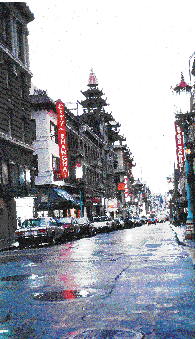ASIAN CALIFORNIA
Page 5 of 12
For all its vast population, the Chinese world is perhaps smaller than you think.
"We've been thrust in the face of so much adversity, it's the only way we've been able to bear through," says Chang. "It amazes me to hear people speak badly of Chinatowns when that's where much of our prosperity began."
| "They knew I wasn't a businessman. They wanted to back me because they believed me." |
"Even when I first moved here and there were few Chinese families, I never felt homesick because of our friends," says Richard Lee, an active member in Southern California's Chinese community. "I think that's the key to the so-called 'connections,' because we make life for each other easier. We cook, we talk, we eat, we raise our children together, we never really feel homesick at all. We feel a sense of belonging with each other."
The networks help, but success is not a preset pattern. Consequently there are no typical success stories. But the trend that has taken shape, particularly in California's kingdom of technology, is that the Chinese founding fathers have become the new establishment, the big bosses, the Man.
Take, for instance, David S. Lee, the inventor of the daisywheel printer. His 30 character-per-second printer blew away IBM's standard 10 cps ball-type by 1972. Xerox bought out Lee's Diablo System for $28 million in order to compete with IBM. Lee took those profits, turned around and started Qume Corporation, which in three years was selling printers that were faster, cheaper and more reliable than Xerox's. In 1978, Qume's sales hit $114 million and ITT offered to buy it for $164 million. Lee grabbed his $10 million profit and ran.
In 1985, he assembled 20 investors to buy out Data Technology Corporation (DTC), a company whose sales had dropped from $100 million to $2 million. Within three years, Lee had built back the company's prestige enough to take it public. The capital he raised, along with a bank loan, allowed him to buy back Qume from ITT. Qume's sales had plunged to $40 million. By 1990, Lee boosted Qume's sales back to $220 million.
Currently, Lee owns a majority share in ITC, the leading producer of telephones in the country. Under Lee's umbrella are DTC; Plexsys, a $30 million maker of cellular base stations; and CMC, a $160 million contract equipment manufacturer.
You wouldn't call Bill Mow, CEO of $750 million Bugle Boy Industries, an average Chinese success story either, but his determination and spirit is certainly indicative of the growing Chinese establishment. In 1969, Mow was working for Litton, a large defense industry conglomerate, where he was soon to begin working on applying integrated circuits to the aerospace industry. A Wall Street collapse, however, dropped the price of Litton's stock from $120 a share to less than $12. Mow knew he would be part of the cutback and immediately went to work on a whole new idea--a company to build the equipment necessary for developing large-scale integrations of metal oxide semiconductors, more commonly known as computer chips.
Mow presented to five investors. Four backed the plan. "They knew I wasn't a businessman," says Mow, "they wanted to back me because they believed me." One investor provided $500,000 in capital and $1.5 million in loans. Thus was born Macrodata.
Mow built a machine capable of measuring the speed of logic chips, random access memory (RAM) chips and micro-processors. The initial machine--five to ten thousand transistors linked together--now resides in the German Museum of Technology in Munich. Macrodata and Mow enabled the birth of modern computer chip technology. His machine measured processor speed down to the billionth of a second, allowing the various functions of the chip to be timed precisely. Micro technology was on its way. By 1972, Macrodata was growing and badly needed funds to keep up. Mow took the company public, offering 70%, and ended up taking $360,000 home with him. He bought a 5-bedroom, 4,000-square-foot house on a one-acre lot in Woodland Hills. In 1976, Cutler-Hammer bought enough shares of the company to replace Mow with its own executive. Mow was moved to chief scientific officer. He sued, and years later collected $1.1 million for his remaining interest. Not much for the granddaddy of the micro age. But he was far from down and out.

California's Chinatowns glitter with tourist activity and serve as a haven for newly arrived immigrants. San Francisco's Chinatown attracts 50,000 visitors per year. |
Mow mortgaged his home to start his wildly successful Bugle Boy jeans, now second only to Levi's in the global mens' and boys' casual wear market. After a number of pitfalls, including announcing its first Fall line in June when the rest of the fashion world had come forward in March, Bugle Boy concentrated on its niche--value-priced, stylish jeans. From parachute pants to commercials of fast-driving babes asking roadside studs, "Excuse me, are those Bugle Boy jeans?" Mow created a veritable fashion empire.
Now his sprawling glass and concrete office complex, his 1.4-acre, 9,000-square-foot Brentwood estate and three Ferraris are only a physical manifestation of the Chinese establishment.
It's only fitting that those who laid the foundation of this country's economic success now lead us into a technologically advanced future. Page 6
| Page 1 |
2 |
3 |
4 |
5 |
6 |
7 |
8 |
9 |
10 |
11 |
12 |
CONTACT US
|
ADVERTISING INFO
© 1996-2013 Asian Media Group Inc
No part of the contents of this site may be reproduced without prior written permission.
